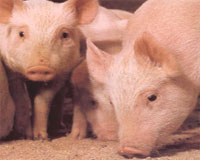Measuring amino acids in pigs – new method

New methods of measuring the amino acid requirement of pigs aim to reduce feed use, protect the environment and improve the economy for farmers.
Measuring methods that have been used for years to get the right blend of amino acids in pig feed may in future be replaced by a far more precise method, which could also improve the feed uptake in pigs and therefore benefit the environment and the economy of the industry. This is the ambition of a new research project, which Jan Værum Nørgaard – scientist at Aarhus University – has just received 4.1m DKK funding for from The Danish Council for Independent Research, Technology and Production Sciences.
“Our experiments with standards for amino acids are currently based on a technique that we have been using for many years. We have not really moved on, and the industry could do with a more precise method. Because the reality is that we can set up 10 feeding experiments and get 10 different conclusions,” explains Nørgaard.
Right balance, better growth
The current methods are based on the so-called dose-response systems, whereby scientists test how different levels of amino acids affect the growth and feed consumption in the animals. A correct balance in the amino acid composition is crucial to get the optimal utilization of the protein in the feed and the best conditions for growth for the pigs.
The current methods are based on the so-called dose-response systems, whereby scientists test how different levels of amino acids affect the growth and feed consumption in the animals. A correct balance in the amino acid composition is crucial to get the optimal utilization of the protein in the feed and the best conditions for growth for the pigs.
In the project Nørgaard will be studying the three branched-chain amino acids – valine, leucine and isoleucine – that are finding their way into feed mixtures.
“We will look for physical markers in urine and blood from pigs fed different amounts of branched-chain amino acids. These substances will reflect the metabolism of specific amino acids and can therefore be used as indicators or as markers of an imbalance in the relationship between the different amino acids in the feed,” he says.
So far, the experiments with amino acids have consisted of the pigs being allocated a feed mixture over a period of four weeks and subsequently determining their growth, but Nørgaard thinks this process can be cut back to two days.
“We feed the animals over two days with a specific feed mixture and this is enough for them to adopt the new amino acid levels from the feed. By measuring the plasma urea concentration in the blood we get an indication of the influence of the feed on the amino acid balance in the pig. A lower concentration of plasma urea will lead to less excretion of nitrogen and thus a better feed use efficiency,” explains Nørgaard. He expects that the identified markers can become part of new measuring parameters in standard trials just as plasma urea has been for some time. If they succeed in identifying and validating new markers, this will lead to a more precise method for determining amino acid standards.
“The physiological markers are initially thought as a supplement to the current methods and can give us a better basis for decisions. But our expectations of the project and the markers are that they will work so well that we will be relying exclusively on them in the future. This will really speed up the determination of correct amino acid compositions,” explains Nørgaard.
The project runs from 1 January 2012 and until 31 December 2014.
In addition to a grant from The Danish Council for Independent Research, Technology and Production Sciences, the project is supported by Ajinomoto, one of the world’s leading producers of amino acids, and the Pig Research Centre, which will be helping with the communication of project results.
(Tekst: Søren Tobberup Hansen)
Source: Aarhus University











